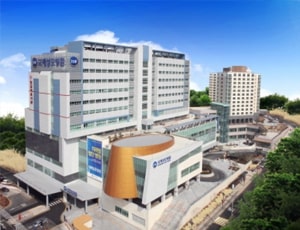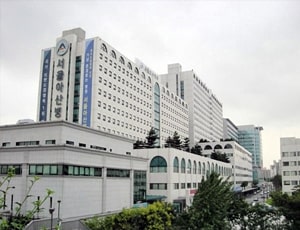Treatment cost

International St. Mary's Hospital located in Seoul, South Korea is accredited by JCI. Also listed below are some of the most prominent infrastructural details:


Asan Medical Centre located in Seoul, South Korea is accredited by ISO. Also listed below are some of the most prominent infrastructural details:
Skin cancer is the most common type of cancer. It typically affects people with lighter skin tone. Skin cancer is the uncontrolled and abnormal growth of destructive malignant skin cells. It occurs when unrepairable DNA damage that occurs in the skin cells triggers a mutation that makes them multiply rapidly and form malignant skin tumors.
Skin cancer is mostly caused by ultraviolet radiation from sunshine or tanning beds. Skin cancers have a limited potential to spread to other parts of the body and may become life-threatening if not treated on time. They are common and can be effectively treated but the treatment of some forms of skin cancers can be difficult. However, early diagnosis and treatment can increase the survival rate.
The following are the three common types of skin cancers:
There are also some other types of skin cancers such as Merkel cell skin cancer, Kaposi sarcoma skin cancer and lymphoma of the skin, but these are rare. Although, some of these are aggressive skin cancers and has a high risk of recurrence.
The typical skin cancer symptoms vary from patient to patient. The symptoms also vary depending on the type of skin cancer that the patient has.
However, basal and squamous skin cancers can have some common symptoms, which include:
Melanoma skin cancer can have some different types of skin cancer symptoms. There is an ABCDE rule guide that explains the melanoma symptoms:
Several effective skin cancer treatment modalities are available, which is selected depending on the type of skin cancer that the patient is suffering from. Your dermatologist will choose the best suitable treatment for you depending on the type of skin cancer, location, your age, general health, and condition (whether the cancer is primary or a recurrence).
Some of the common treatment options for skin cancer include the following:
Destruction of skin cancer by electrodesiccation and curettage is known as EDC therapy. This treatment is fast, easy, and less expensive in comparison to other skin cancer treatment options. In this treatment, the area of the affected skin is numbed with a local anesthetic and scraped repeatedly with a sharp instrument called curette. After that, the edge is cauterized with an electric needle.
Surgery is a more complicated and expensive procedure than EDC. During this skin cancer treatment, the surgeon first numbs the affected area with a local anesthetic. Then the malignant skin tissues are fully removed. Lastly, the edges of the wounds are closed with sutures. Surgery has a greater cure rate and the scar produced is usually more cosmetically acceptable than EDC procedure.
Mohs surgery for skin cancer is a microscopically-controlled treatment performed for common types of skin cancer. During this treatment, the surgeon keeps on removing layers of tissues and see it under the microscope to look for cancer cells.
Radiation therapy is an option when the patient is not suitable for surgical treatment such as the elderly. The treated area cannot be tested to be sure that the entire cancer is gone and the radiation scar looks worse over time.
In the case of basal cell skin cancer, some gels, creams, and solutions can be used to reduce cancerous cells.
Chemotherapy drugs such as fluorouracil (5-FU) can be given orally to the patient to treat skin cancer. It works by stimulating the body's immune system to produce interferon, which attacks the cancer cells.
Alternative therapy includes the use of herbs, vitamins, and special diets, or other methods such as acupuncture or massage. Alternative therapy, however, cannot be used alone to treat skin cancer completely. It can only be used to reduce the severity of the symptoms.
Ask your healthcare adviser for the best multiple options and choose the one that meets your expectations
Skin Cancer Treatment cost in Seoul varies from one hospital to the other. There are many hospital who cover the cost of pre-surgical investigations of the patient in the treatment package. Typically, the package cost of Skin Cancer Treatment in Seoul includes the expenses related to the surgeon's fee, anesthesia, hospital, meals, nursing and ICU stay. A prolonged hospital stay due to delayed recovery, new diagnosis and complications after surgery may increase the cost of Skin Cancer Treatment in Seoul.
Many hospitals in Seoul perform Skin Cancer Treatment. For quick reference, the following are some of the leading hospitals for Skin Cancer Treatment in Seoul:
The recovery of the patient many vary, depending on several factors. However, on an average, patient is supposed to stay for about 21 days in the country after discharge. This time frame is important to ensure that the surgery was successful and the patient is fit to fly back.
Apart from the Skin Cancer Treatment cost, there are a few other daily charges that the patient may have to pay. The per day extra expenses in Seoul per person are about 40 USD.
The patient has to spend about 4 Days in the hospital after Skin Cancer Treatment for proper recovery and to get clearance for discharge. The doctors team review the patient's recovery during this time with the help of blood tests and imaging scans. Once they feel that everything is on track, the patient is discharged.
There are more than 2 Hospitals that offer Skin Cancer Treatment in Seoul. These hospitals have proper infrastructure for the treatment of patients who require Skin Cancer Treatment. Additionally, these hospitals are known to comply with the international standards as well as local legal requirements for the treatment of patients.
Some of the most sought after doctors for Skin Cancer Treatment in Seoul are: